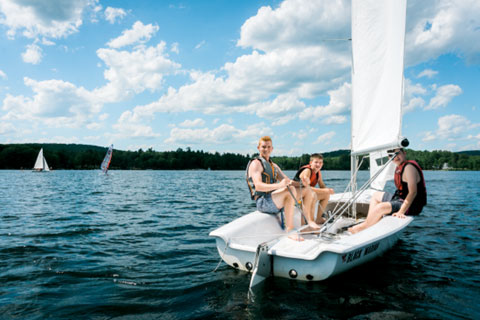
Last June, “Swampy,” a second-generation camper, left his job as a classroom teacher in Boston to become a program coordinator for an outdoor education program in Jackson, WY.
Cox’n: Did your Agawam Katahdin trips influence your decision to take this job?
Swampy: Definitely. I spoke a lot about those trips in my cover letter and interviews—how my prior experience leading multi-day backpacking trips really prepared me for this role. At Agawam, I think we sometimes overlook how significant those trips are. It’s a huge undertaking to bring kids into the backcountry for multiple days, covering a lot of mileage.

Swampy preparing to climb, pre-triumph
Note from Cox’n: For those that don’t know, there’s a huge difference between backcountry and frontcountry. Frontcountry is like a drive-up campsite with bathrooms and running water. If something goes wrong you can just get in your car and leave. Backcountry camping, on the other hand, usually occurs five or more miles off the trail and comes with many more logistics: you have to purify your water, cook meals on tiny camp stoves. It’s more rugged but is ultimately no match for this camp of hairy-chested men. And especially not for “Swampy.”
Swampy: So, this climb in Moab had been on my mind for months. I’d seen photos of it and thought it looked amazing. I’d talked about it for ages, made plans that fell through, and was about to push it off until spring to give myself more time to train. Then, a friend in between jobs hit me up last minute, like, “Let’s go do it this weekend.”

Swampy on top of Moab, triumphant
Swampy: Awful. It was crazy windy—50 mph winds in the desert. We thought it wasn’t smart to attempt the climb, so we had a slow morning hanging out at camp. Then we decided to at least hike out and check it out, planning to turn around if the wind stayed bad. Finding the specific tower we wanted to climb took a couple of hours. It’s not on a marked trail, so we were bushwhacking through the desert with just photos of the route on our phones. By the time we found it, the wind had died down a bit, and we decided to climb a little and see how it went.
Cox’n: How tall was the tower?
Swampy: About 400 feet, which is longer than most rock-climbing ropes.
Cox’n: No pressure, right?
Swampy: (Laughs) Right. And because of how ropes work, if I’m 10 feet from the anchor and I fall, I actually fall 20 feet—10 feet of slack in the rope, plus the 10 feet of air I drop. So by the time we got there, the wind had died down, the sun was low in the sky, and it was close to sunset. We talked about it and decided we could go for it. I just took a deep breath, blocked out any thought of falling, and walked out onto this plank—basically a two-foot-wide ledge with a 400-foot drop on either side.
Cox’n: Oh my God, I’m getting nervous just hearing about this.
Swampy: Honestly, I was way more nervous the night before during the eight-hour drive or that morning around camp. But once it was time to actually do it, I kind of went into this laser-focused state. Even now, talking about it, I don’t fully remember every moment because I was so locked in. It’s like everything else got blocked out, and it was just about walking forward and not freaking out.

Swampy on top of things in the boat, triumphant
